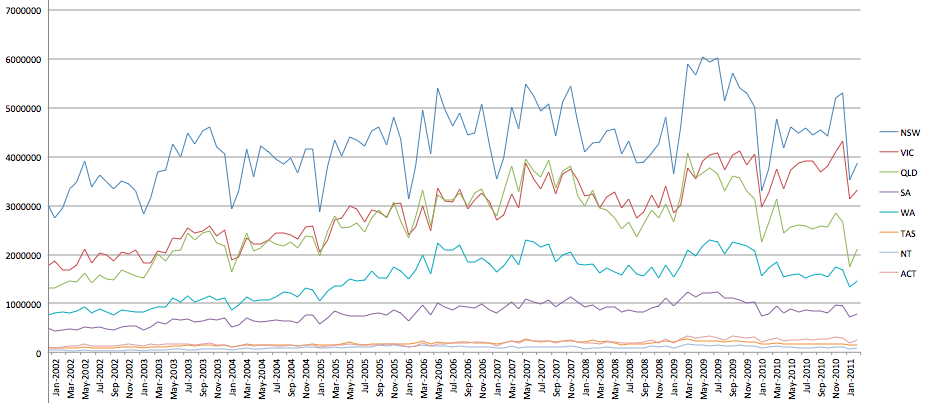As H&H reported today the housing finance data for February is simply plain bad. This is not a surprise to me as I have been warning about this for some time now. As I have been saying recently I simply could not see any drivers for new credit and it looks like I was correct in that assessment with a large fall in seasonally adjusted housing finance numbers.
However the seasonally adjusted numbers hide some very interesting details. As my readers would know I prefer long running raw datasets so I can see the patterns for myself without data manipulation. The raw data for the 5609 ABS dataset is very telling. Below is the value($) of owner occupier loans issued per month for each state.

You can see that what usually happens each year from the data. The value falls off in January, bounces back in February to a level near or above the previous November, moves around a bit during the year and then falls back next January with an overall YoY upward trend. There was only one year in the decade preceding 2010 when this didn’t occur and that was 2008 the year of the GFC. Now have a look at 2011. What do you see ? No bounce in February!! Just as I said last week, it is 2008 again
Previously I have also stated.
[I’ll] say it once, [I’ll] say it again. Sustained falls in the rate of debt issuance in a debt driven economy lead to recession.
Now look at the trend and current level of debt issuance in Western Australia. It is down and now sits at 2005 levels so it shouldn’t be too much of a surprise to read this.
Western Australia is generally regarded as Australia’s economic engine room with its booming resources sector, but its manufacturing and retail sectors are struggling.
The WA Chamber of Commerce says the state’s economy experienced a technical recession in the last six months of last year.
“The state of Western Australia very much mirrors the broader national economy in that there is very much a two-speed economy at play,” said John Nicolaou, the chamber’s chief economist.
“You have the resources sector and anything connected to that sector that’s performing very strongly.
“Against that you have other sectors in the domestic economy, particularly those consumer facing sectors which are struggling.”
I note that Access Economics seemed to have predicted WA’s troubles back in 2009.
You will also notice that my favourite state Queensland is in an even worse predicament with current OO credit issuance back at 2004 levels (Remember this is not population adjusted data). I suspect a mix of capital spending by the miners and the sale of QR national that raised $4.6 billion for the government have been able kept the books in black for now. However I am doubtful this will be able to offset the falls in credit for too much longer. I therefore expect to see Queensland joining WA shortly.
I am getting the feeling we didn’t actually avoid the GFC at all, we just avoided it for a few years.